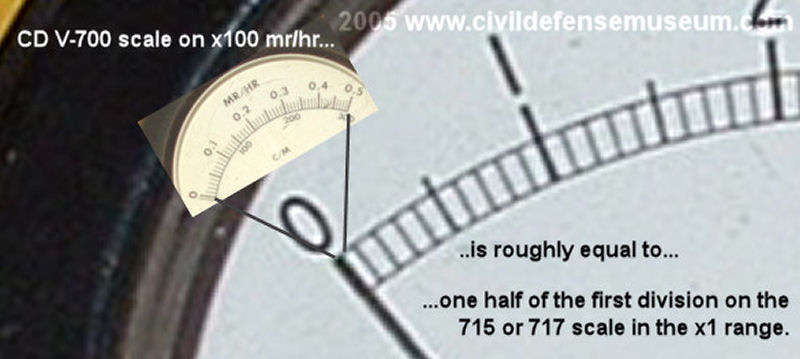
Low/High Range Comparison
CD V Stuff Main
Radiation Kits
CD V-777 Kit
CD V-777A Kit
CD V-777-1 Kit
CD V-777-2 Kit
CD V-777-4 Kit
CD V-755
High School Kit
Radiation Instruments
CD V-700
CD V-700
Prototypes
CD V-710
CD V-711
CD V-715
CD V-717
CD V-718
CD V-720
CD V-750 and Dosimeters
Other Sets
CD V-781
Aerial Set
CD V-757
Barrier Set
CD V-457
Class Set
Commercially
Sold Radiation Meters
Low Range
High Range
Comparison
Two State
RADEF Shops
Supplies Main
Back to Civil Defense Museum Main
Civil Defense Radiation Meter Scale Comparison CD V-700 vs. CD V-715 & CD V-717.
The purpose of this page is to try to demonstrate the large difference between the CD V-700 detection range and the CD V-715/CD V-717 detection ranges. I first thought of doing this while browsing Ebay auctions. The endless auction listings of the Civil Defense high-range ion chamber instruments as "Geiger Counters" is the primary reason for this page. I hope some who are thinking about starting a collection of these meters will see this page first before starting to buy instruments. Obviously I think all of the CD instruments are super-cool. I have dozens of the high range instruments but beginning collectors should know that there is really nothing much you can do with the high-range instruments other than display them. Here is a rough comparison between the scale ranges of a CD V-715 and CD V-700. Keep in mind this is an approximate comparison because the CD V-715 and CD V-700 detect radiation in different ways.

The entire CD V-700 scale range (inset in photo) set on the x100 range
(highest range for the CD V-700) is roughly equal to the first 5
scale divisions on the CD V-715 or CD V-717 scale (large scale in photo)
set on the x0.1 range (lowest setting on the CD V-715 or CD V-717).
A gamma source reading 20mr/hr (probe shield closed) on a CD V-700 won't
necessarily translate directly to the CD V-715/717. In other words if you
have a source reading 20mr/hr on a CD V-700 you can't necessarily just stick
it under a CD V-715/717 and have it read on the first 2 scale divisions. I most likely
won't move the needle on the CD V-715/717 at all.

The entire CD V-700 scale range (inset in photo) set on the x100 range
is roughly equal to one half of the first division on the CD V-715
or CD V-717 scale (large scale in photo) set on the x1 range. This comparison
really shows the extreme difference in the CD V-700 and the CD V-715/717s.
I think the only way you could really compare the two types of instruments is to have a uniform gamma radiation "field" surrounding the instrument. These meters were intended to be held at waist height when measuring fallout radiation levels. For example if you were in a large area where you would measure, say, 40mr/hr on a CD V-700 with probe closed and the instrument held a waist height, you should be able to hold a CD V-715 at waist height with the range set on x.1 and get (if both the "700" and "715" were perfectly calibrated and accurate that is) a needle reading on the CD V-715 on the fourth small scale division.
AN ADDITIONAL NOTE: I have an old aircraft turn and bank indicator with a radium dial (seen here CD V-700 reading 10 mr/hr ) that will read 10 mr/hr on a CD V-700 with the probe closed. The reason this turn and bank indicator reads so high is because it has a large (about .75 inch x 2 inch) piece of radium-painted material behind the turn and bank ball tube. I have a Landers Frary & Clark CD V-715 Model 1A that the needle will go up scale about half of one scale division when placing the turn and bank indicator under the ion chamber with the case bottom removed. The LF&C isn't calibrated but the needle does move. I've tried the same thing with 2 calibrated Victoreen CD V-715s that I have and the needles on both of those don't budge. Not that scientific of an experiment but I thought I would mention it.